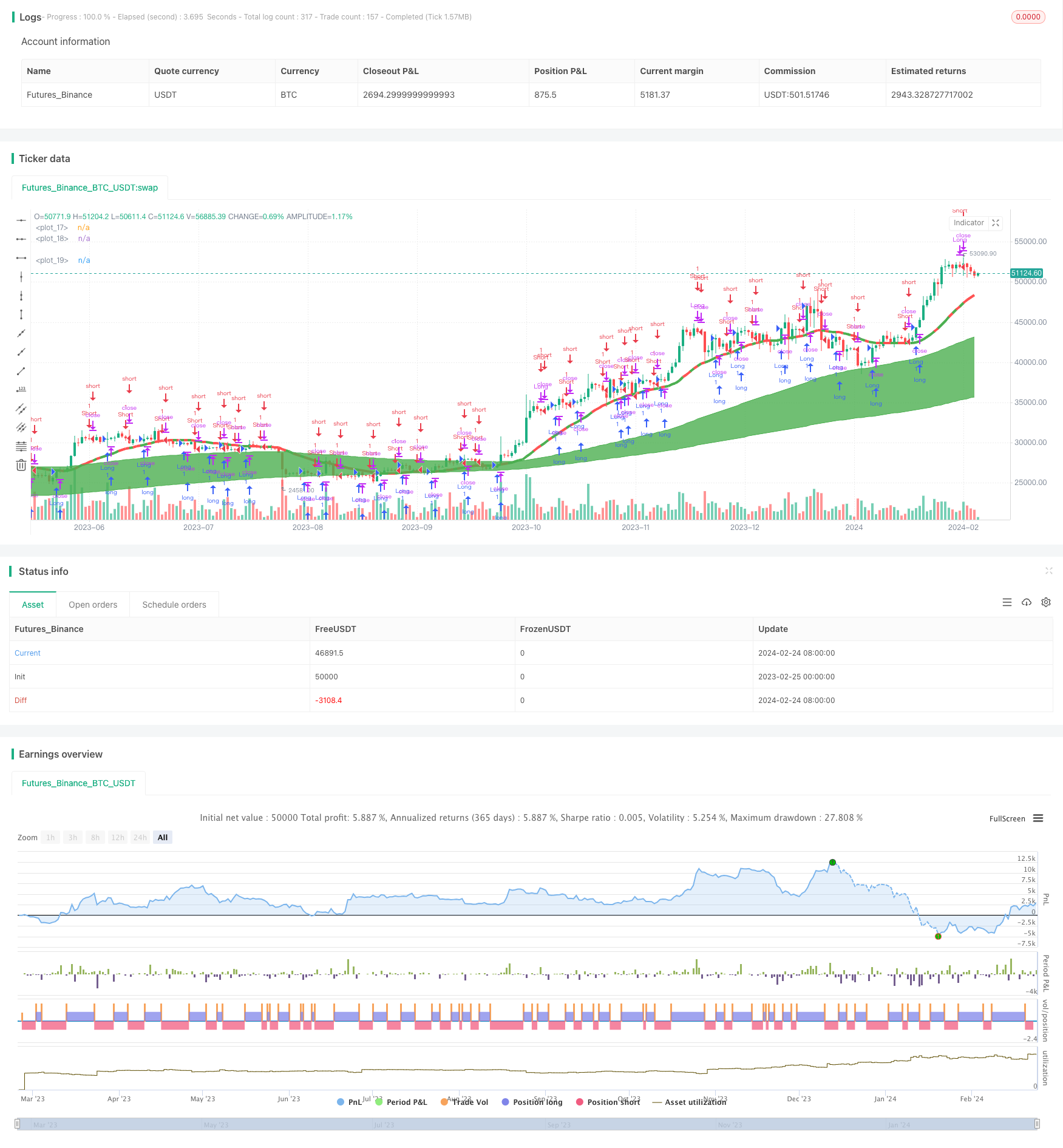
概述
双移动平均 HullMA交叉趋势策略是一种基于双移动平均线交叉的趋势跟踪策略。它使用加权移动平均线WMA构建双移动平均系统,并在它们交叉时生成交易信号。该策略同时结合价格突破判断,进一步过滤信号。
策略原理
双移动平均 HullMA交叉趋势策略使用三条不同周期的WMA线,包括wma1、wma2和wma3。wma2和wma3构建双移动平均系统,当wma2上穿wma3时为看涨信号,而wma2下穿wma3时为看跌信号。wma1是辅助判断线。
该策略额外使用Hull移动平均加强信号判断。具体来说,它计算2日加权移动平均线的两倍n2ma和n日加权移动平均线nma的差值,并测度差值数值的变化。只有当差值上升时才会确认看涨信号有效,差值下降时才会确认看跌信号有效。
该策略同时结合价格判定。只有在价格比前一日价格高时,才会确认看涨信号有效生成做多单。只有价格比前一日价格低时,才会确认看跌信号有效生成做空单。
优势分析
双移动平均HullMA交叉趋势策略结合双移动平均交叉和价格判定,可以有效滤除假信号,这是它的最大优势。此外,该策略运用三条不同周期的移动平均线捕捉不同级别的趋势,可以在趋势初期就进入市场。它的止损清算方式也比较稳定可靠。
风险分析
双移动平均HullMA交叉趋势策略作为一种趋势跟踪策略,在盘整行情中容易产生较多交易次数和滑点损失。此外,双移动平均线交叉系统过于敏感,可能在 sideways发出错误信号。建议适当调整移动平均线参数,或增加附加过滤条件。
优化方向
双移动平均HullMA交叉趋势策略可以从以下几个方面进行优化:
优化移动平均线参数,找到最优参数组合
增加成交量或者波动率等过滤器,排除假突破
结合其它指标作为辅助判断,提高信号质量
动态优化移动平均周期参数
总结
双移动平均HullMA交叉趋势策略整体来说是一个稳定可靠的趋势跟踪策略。它结合双移动平均交叉和价格判定产生高质量信号。通过参数优化和添加过滤器,可以进一步减少错误信号,从而获得更好的策略表现。该策略适用于捕捉中长线趋势,是量化交易的一个不错选择。
/*backtest
start: 2023-02-25 00:00:00
end: 2024-02-25 00:00:00
period: 1d
basePeriod: 1h
exchanges: [{"eid":"Futures_Binance","currency":"BTC_USDT"}]
*/
//@version=2
strategy("ZendicatoR", overlay=true)
dt = input(defval=0.0010, title="Decision Threshold", type=float, step=0.0001)
keh=input(title="Double HullMA Cross",defval=7, minval=1)
che1=input(title="MA 1",defval=34,minval=1)
che2=input(title="MA 2",defval=144,minval=1)
che3=input(title="MA 3",defval=377,minval=1)
amnt=input(title="TP ($)",defval=4200,minval=1)
wma1=wma(close,che1)
wma2=wma(close,che2)
wma3=wma(close,che3)
tms=10000000000000
A=request.security(syminfo.tickerid, 'D', close)*tms
B=request.security(syminfo.tickerid, 'D', close[1])*tms
C=A>B?green:red
D=wma2>wma3?green:red
plot(wma1,style=line,color=C,linewidth=4)
p1=plot(wma2,style=line,color=D)
p2=plot(wma3,style=line,color=D)
fill(p1, p2, color=D, transp=75)
n2ma=2*wma(close,round(keh/2))
nma=wma(close,keh)
diff=n2ma-nma,sqn=round(sqrt(keh))
n2ma1=2*wma(close[2],round(keh/2))
nma1=wma(close[2],keh)
diff1=n2ma1-nma1,sqn1=round(sqrt(keh))
n1=wma(diff,sqn)*tms
n2=wma(diff1,sqn)*tms
closelong = A*tms<B*tms and n2*tms>n1*tms and strategy.openprofit>amnt
if (closelong)
strategy.close("Long")
closeshort = A*tms>B*tms and n1*tms>n2*tms and strategy.openprofit>amnt
if (closeshort)
strategy.close("Short")
longCondition = A*tms>B*tms and n1*tms>n2*tms
if (longCondition)
strategy.entry("Long",strategy.long)
shortCondition = A*tms<B*tms and n1*tms<n2*tms
if (shortCondition)
strategy.entry("Short",strategy.short)